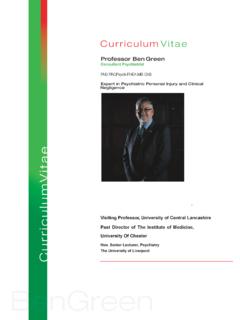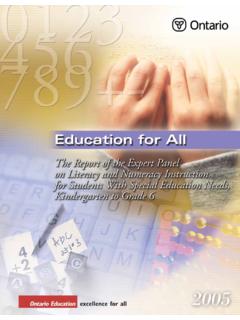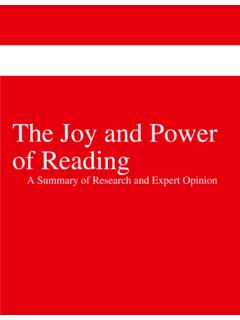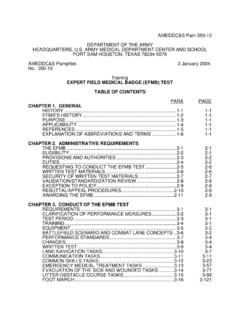Transcription of General Assembly - UNICEF
1 United Nations A/61/299 General Assembly Distr.: General 29 August 2006 Original: English 06-49105 (E) 280906 *0649105* Sixty-first session Item 62 (a) of the provisional agenda* Promotion and protection of the rights of children Rights of the child Note by the Secretary- General The Secretary- General has the honour to transmit to the members of the General Assembly the report of the independent expert for the United Nations study on violence against children, Paulo S rgio Pinheiro, submitted pursuant to General Assembly resolution 60/231. The Secretary- General trusts that the General Assembly will give thorough consideration to this study and to the mechanisms required for following up and monitoring the implementation of the conclusions and recommendations it will adopt on this important subject.
2 * A/61/150. A/61/299 06-49105 2 Report of the independent expert for the United Nations study on violence against children Summary This report, which is based on the in-depth study of Paulo S rgio Pinheiro, independent expert appointed by the Secretary- General pursuant to General - Assembly resolution 57/90 of 2002, provides a global picture of violence against children and proposes recommendations to prevent and respond to this issue. It provides information on the incidence of various types of violence against children within the family, schools, alternative care institutions and detention facilities, places where children work and communities.
3 The Study is accompanied by a book which provides a more detailed account of the Study. The Study was prepared through a participatory process which included regional, subregional and national consultations, expert thematic meetings and field visits. Many Governments also provided comprehensive responses to a questionnaire transmitted to them by the independent expert in 2004. The independent expert is grateful for the broad support for his work provided by Governments, regional bodies and intergovernmental bodies, as well as from United Nations entities, civil society organizations and children.
4 A/61/299 3 06-49105 Contents ParagraphsPageI. Introduction: protecting children from 235A. Mandate and scope of the 105B. The Study 236II. A global 378A. Hidden, unreported and 278B. Emerging Risk and protective 3510D. A wide range of 3711 III. Settings in which violence against children 8012A. Home and 4712B. Violence in schools and educational 5215C. Violence in care and justice 6316D. Violence in work 6818E. Violence in the 8019IV. Progress 8922V. 9324VI. 12325A. Overarching 109251. Strengthen national and local commitment and Prohibit all violence against 98253. Prioritize Promote non-violent values and Enhance the capacity of all who work with and for Provide recovery and social reintegration Ensure participation of Create accessible and child-friendly reporting systems and Ensure accountability and end Address the gender dimension of violence against Develop and implement systematic national data collection and Strengthen international 10927A/61/299 06-49105 4 B.
5 Setting-specific 114281. In the home and In schools and other educational In care and justice In the workplace ..113305. In the Implementation and 123321. National and regional 119322. International 12333 A/61/299 5 06-49105 I. Introduction: protecting children from violence 1. No violence against children is justifiable; all violence against children is preventable. Yet the in-depth study on violence against children (the Study) confirms that such violence exists in every country of the world, cutting across culture, class, education, income and ethnic origin.
6 In every region, in contradiction to human rights obligations and children s developmental needs, violence against children is socially approved, and is frequently legal and State-authorized. 2. The Study should mark a turning point an end to adult justification of violence against children, whether accepted as tradition or disguised as discipline . There can be no compromise in challenging violence against children. Children s uniqueness their potential and vulnerability, their dependence on adults makes it imperative that they have more, not less, protection from violence.
7 3. Every society, no matter its cultural, economic or social background, can and must stop violence against children. This does not mean sanctioning perpetrators only, but requires transformation of the mindset of societies and the underlying economic and social conditions associated with violence. 4. This Study is the first comprehensive, global study conducted by the United Nations on all forms of violence against children. It builds on the study on the impact of armed conflict on children, which was prepared by Gra a Machel presented to the General Assembly 10 years ago, and is inspired by the World Health Organization s World Report on Violence and Health.
8 It is also the first global study to engage directly and consistently with children. Children have participated in all regional consultations held in connection with the Study, eloquently describing both the violence they experience and their proposals for ending it. 5. Violence against children is multidimensional and calls for a multifaceted response. This Study combines human rights, public health and child protection perspectives, and experts in these different fields have collaborated to support its preparation. The Study has benefited from the growing body of scientific studies that have examined the causes, consequences and preventability of violence against children.
9 6. Protection of children from violence is a matter of urgency. Children have suffered adult violence unseen and unheard for centuries. Now that the scale and impact of all forms of violence against children is becoming better known, children must be provided with the effective prevention and protection to which they have an unqualified right. A. Mandate and scope of the Study 7. In 2001, on the recommendation of the Committee on the Rights of the Child, the General Assembly in its resolution 56/138 requested the Secretary- General to conduct an in-depth study on the question of violence against children and to put forward recommendations for consideration by Member States for appropriate action.
10 In February 2003, I was appointed by the Secretary- General to lead this study. A/61/299 06-49105 6 8. The Study adopts the definition of the child as contained in article 1 of the Convention on the Rights of the Child: [e]very human being below the age of eighteen years unless, under the law applicable to the child, majority is attained earlier . The definition of violence is that of article 19 of the Convention: all forms of physical or mental violence, injury and abuse, neglect or negligent treatment, maltreatment or exploitation, including sexual abuse . It also draws on the definition in the World Report on Violence and Health (2002): the intentional use of physical force or power, threatened or actual, against a child, by an individual or group, that either results in or has a high likelihood of resulting in actual or potential harm to the child s health, survival, development or 9.

















